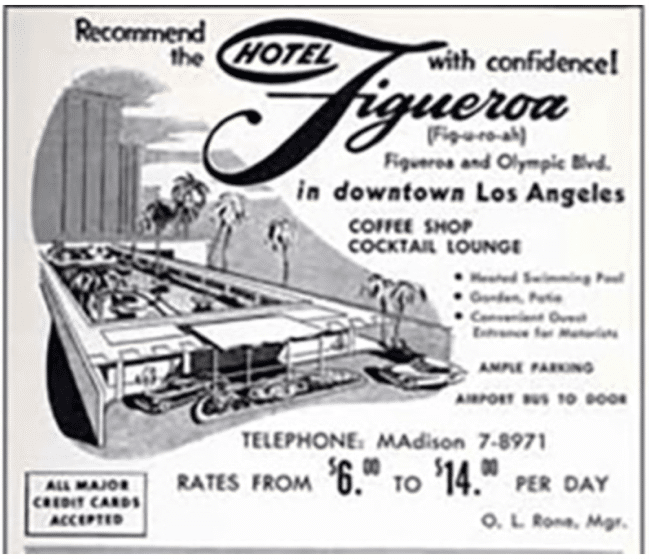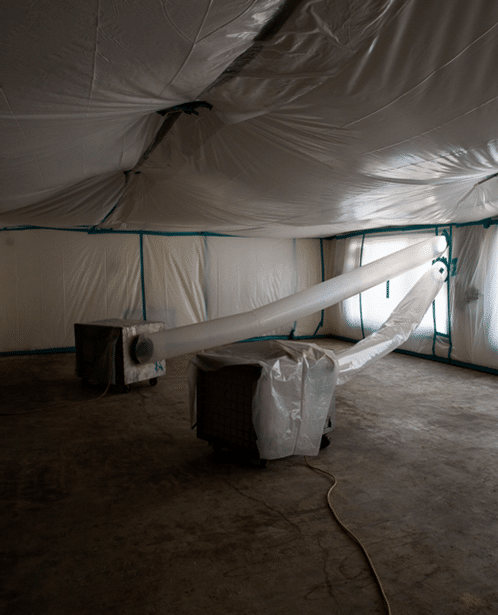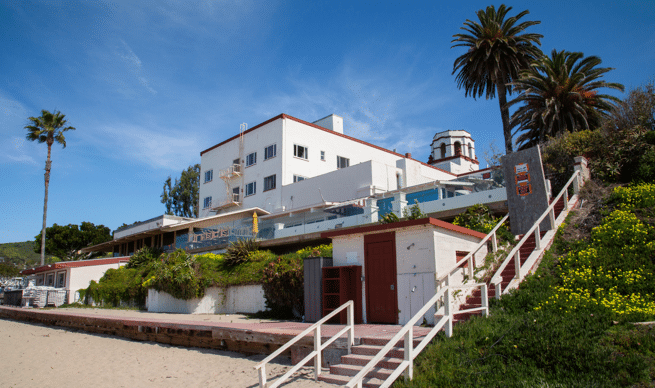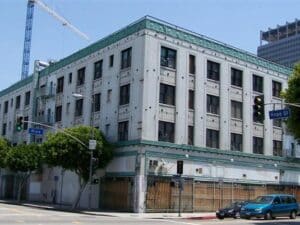Reviving a Vivid Historical Era – Minus the Asbestos and Lead

Long a destination for visitors as one of the world’s most glamorous stretches of sun, surf and celebrity playground, Southern California is dotted with historic hotels that can leave you California dreamin’ of another era.
But renovating these historical gems takes more than imagination. It’s a complex work of preservation, permitting, engineering, and environmental due diligence.
Of course, if it were easy, any environmental services vendor could manage it. There’s a good reason so many property owners and developers across California turn to Omega Environmental to manage the environmental challenges of their historic renovation projects, including some of the finest examples of historic hotels we know. The stories these walls could tell!
Here are two of them.
 Hotel Figueroa, Los Angeles
Hotel Figueroa, Los Angeles
The remodeling of L.A.’s Hotel Figueroa, a deteriorating 1920s era landmark in the city’s newly thriving downtown, revived a rich backstory of 1920s-era women, newly enfranchised and making their way in the world.
Built in 1926 by the Young Women’s Christian Association (YWCA) and managed by a “first of her kind” female general manager whose portrait now hangs in the check-in area, the hotel was originally a Spanish Colonial-style inn dedicated to providing a safe space for female travelers and professionals. According to the Los Angeles Times, the hotel was, at the time, “the largest project of its kind in the United States to be financed, owned, and operated by women” – a substantial feat considering women had won the right to vote only six years prior. According to the hotel’s website, the hotel was women-only for its first two years.
But the restoration of this iconic structure required dealing with the less celebratory historical legacy of 1920s-era construction, which made liberal use of materials now known to be hazardous.
A Less Celebrated History in Harmful Building Materials
Known for its incredible versatility and heat resistance, asbestos was favored in the 19th and early 20th centuries for everything from insulation to pipelines and other building materials. Lead, also a common household and commercial material, was used for things like paint and gasoline.
A year after Hotel Figueroa was erected, the first official workers’ compensation claim for asbestos-related disease in the U.S. was filed, according to the International Journal of Environmental Research and Public Health. At the same time, many developed countries such as Australia and Sweden passed lead paint prevention acts, but the United States was not among them. It wasn’t until the early 1970s that national asbestos and lead regulations were enacted.
In 2014, Hotel Figueroa’s new owners undertook a multi-million-dollar renovation. The new owners envisioned a luxury hotel with some of the original 1920s flair.
Their initial plan was to remodel certain parts of the hotel, but after Omega conducted a hazardous materials assessment of the property, it was determined that major components and areas of the building required remediation. This entailed a full demolition of the interior – a project that took nearly two years to complete.
Because the hotel is a protected historical landmark, significant portions of the hotel’s original structure had to remain intact. This added to the challenge of remodeling a building that already had unreliable elevators and other safety concerns.
To facilitate the asbestos and lead remediation process, an exterior elevator was installed to move securely between the 14 floors. Some of the ductwork in the building had to be removed to work around the mechanical system and shafts, and gaping holes in the floors had to be covered to ensure worker safety. Omega engineered solutions that allowed remediation to proceed safely and effectively.
The Hotel Laguna, Laguna Beach
Described as one of the most recognizable landmarks on one of Southern California’s most iconic beaches, the Hotel Laguna almost didn’t survive into a new century.
Built in the 1880s, the original structure was torn down in 1928 because of fire safety issues and rebuilt around 1930, according to a news account.
A four-year renovation effort was begun to salvage the historic property and Omega was brought in to manage the environmental issues, specifically hazardous building materials.
Our hazardous materials survey revealed hazards commonly found in 1930s era construction and we managed the containment and removal of asbestos tiles, lead-based paint and PCB-containing light fixtures, all while carefully keeping the work out of view of the throngs of tourists.
Today, the reopened lobby and a first-floor restaurant is an elegant – and contaminant-free – gathering spot overlooking the Pacific.
Omega President and Project Director Steve Rosas said getting the work done without spoiling the iconic view was a challenge, but the company managed to keep its hazmat-suited workers out of sight. “Of course,” he said, “It’s pretty hard to ruin the view in Laguna.”
Diligent and Professional Environmental Management for Iconic Properties
Property managers and general contractors understand that environmental assessment and remediation are necessary steps in the restoration process, both to safeguard the environment and the health of the occupants as well as to ensure regulatory compliance. Omega Environmental is a trusted partner in this effort, as much for our broad experience with landmark renovation projects as for our deep expertise in environmental assessment and remediation. We have decades of experience including Ph.D. level expertise in managing the process of lead and asbestos remediation – along with remediation for other hazardous materials – safely, efficiently and cost effectively.
Contact us to earn more about best practices for environmental remediation in historical renovation.












